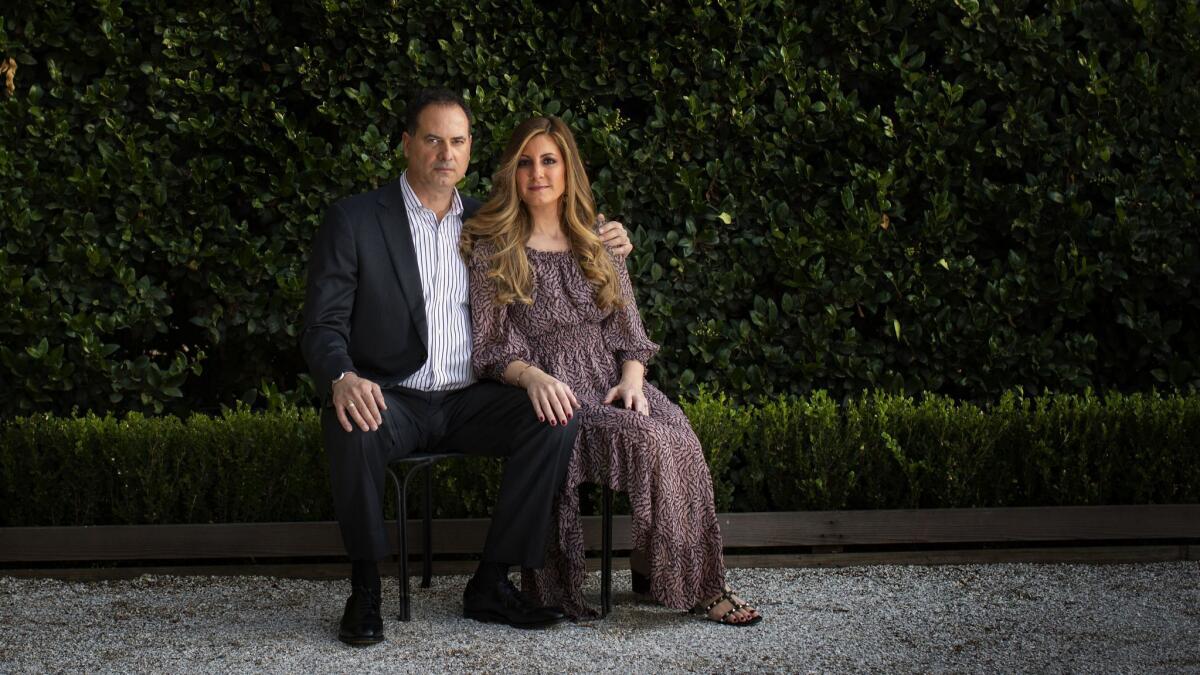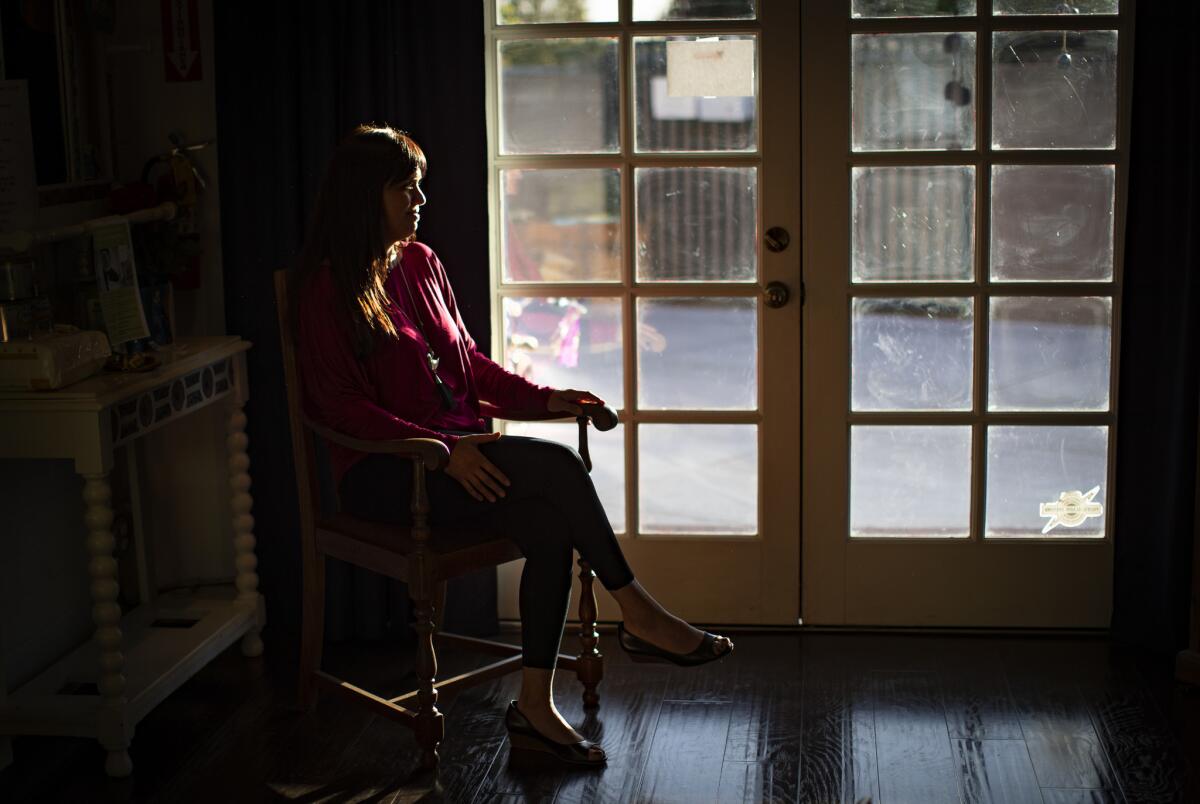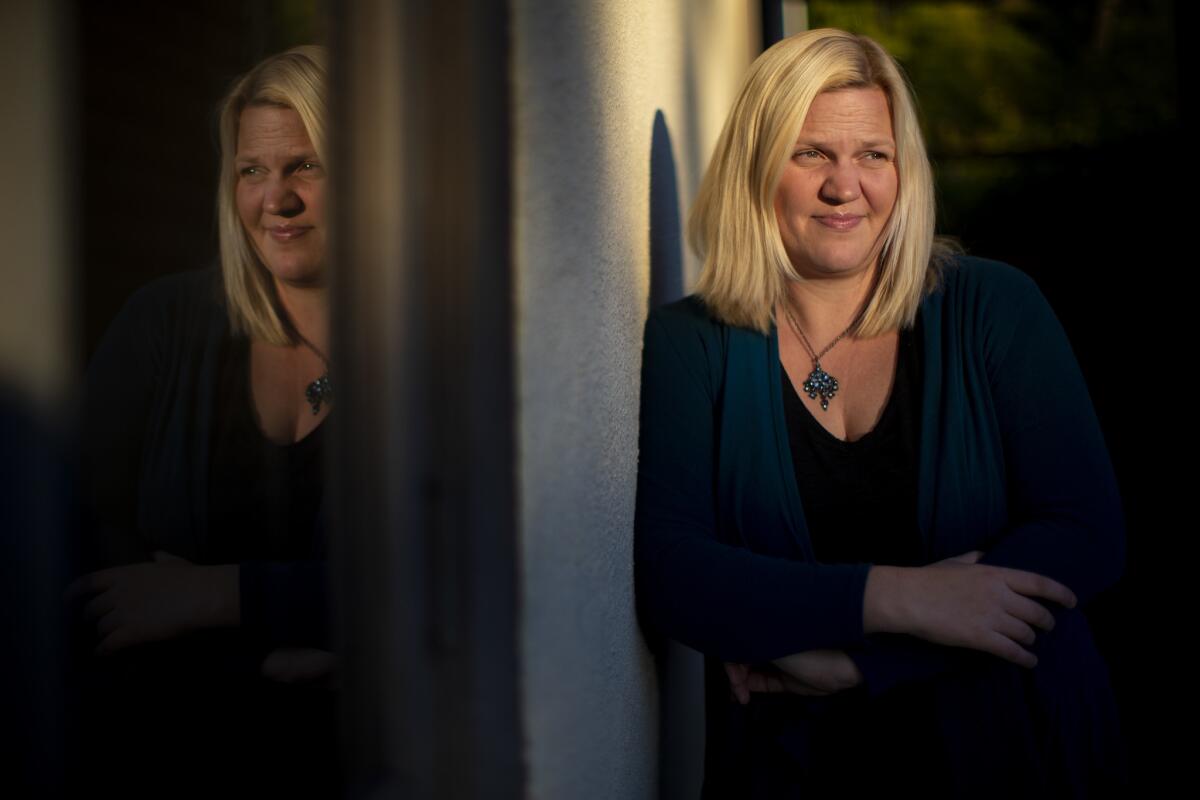Must Reads: More than 20 women accused a prominent Pasadena obstetrician of mistreating them. He denied claims and was able to continue practicing

- Share via
For the birth of their first child, social worker Diane Vidalakis and her husband chose one of Pasadena’s most prominent obstetricians, Dr. Patrick Sutton, vice chair of obstetrics and gynecology at Huntington Memorial Hospital.
Labor initially progressed smoothly, with the couple listening to music and watching “Dancing With the Stars” in the hospital maternity ward.
Sutton arrived for the delivery in what the Vidalakises would later testify was a frenzied state. He shouted that he had to do an emergency caesarean section and then backtracked, picked up a pair of scissors and made three progressively deeper incisions into the base of Vidalakis’ vagina, according to interviews, court records and a medical board complaint.
A minute later, she delivered a healthy daughter. Her own body, however, was grievously wounded. Vidalakis would never regain control of her bowels, and specialists who examined her would express shock that such extensive injuries resulted from a delivery at an American hospital by a licensed physician.
“I never challenged or questioned his authority,” Vidalakis said in an interview. Without admitting wrongdoing, Sutton settled a 2011 lawsuit she and her husband filed for $750,000.
What Vidalakis and many other women who sought care from Sutton did not know was that he had a long history of patient complaints about his conduct before, during and after labor.
A Times investigation identified more than 20 women who claim Sutton mistreated them during his medical care. Their allegations date to 1989, his first year at Huntington, and include unwanted sexual advances, medical incompetence, the maiming of women’s genitals and the preventable death of an infant. Sutton denied each allegation in an interview with The Times.
Top Huntington administrators were warned repeatedly about Sutton over the decades, according to interviews with current and former administrators and other hospital employees. One obstetrician at the hospital told The Times she complained to Huntington’s chief medical officer and its compliance department on several occasions about what she saw as his poor clinical judgment and misogynistic remarks.
“No matter what concerns I had, they would continue to do nothing,” said Dr. Shawanda Renee Obey.
Unease about Sutton was so widespread at Huntington that some nurses adopted a policy of misleading him about the progress of a woman’s labor to keep him out of the delivery room for as long as possible, according to interviews with more than half a dozen current and former nurses.
Hospital administrators continued backing Sutton, even allowing him for several years to lead internal investigations of other obstetricians. After The Times reported in October that he was facing a fifth accusation of sexual impropriety in court or by the medical board, the hospital announced he would have a chaperone when treating patients.
In early November, the newspaper presented Huntington with a detailed list of questions for this story.
A hospital spokeswoman subsequently said that Sutton was no longer working there, “effective immediately.” In an interview last month, Sutton said the hospital asked him to take a leave of absence or face suspension and he agreed to the leave.

Sutton said he was a good doctor and that the patients who complained represented only a tiny fraction of the thousands of women he cared for during his career. He maintained that the hospital never took any disciplinary action against him until this fall. He also noted that he had prevailed in the only two malpractice cases in his career that went to trial.
“I agree my record looked kind of crappy, and I wish it wasn’t, but that doesn’t mean I’m any risk to patients at all or that patients don’t want to keep seeing me,” Sutton said.
Dr. Lori Morgan, Huntington’s chief executive, declined to answer questions about Sutton, citing state law that makes internal discipline of physicians confidential. She said the hospital’s governing board is forming a committee to reexamine how it grants doctors privileges to practice.
The Times interviewed more than 60 people about Sutton’s practice, including patients, their spouses and family members, birth coaches, nurses, physicians, lawyers and other hospital employees. Many spoke on the condition of anonymity, with some citing potential professional repercussions.
::
The son of a doctor and a social worker, Sutton grew up in Pasadena less than a mile from Huntington. He graduated with honors from Caltech in 1976, and after medical school at the University of Michigan did residency training at California Hospital and L.A. County-USC Medical Center.
Entering private practice in 1989, he chose an office around the corner from Huntington. With its distinctive rose-colored facade, marble fountains and manicured grounds, the hospital has long embodied the aspirations of Pasadena, Southern California’s “city of millionaires.”
Its nationally ranked maternity ward, which welcomes more than 3,500 babies annually, is the heart of the hospital. Tall and strapping, with a bedside manner that could be tender and sweet, Sutton was beloved by many patients, who returned to him for the births of second and third children and recommended him to co-workers, friends and relatives.
“He has a lot of patience and would sit there to make sure all my questions were answered before he moved on,” one patient wrote in a 2011 Yelp review. “My birthing experience was wonderful!”
Others left his care feeling scared, angry and even traumatized. Some made their displeasure known to Sutton, the hospital or the medical board, but some said they shared their experience only with family and close friends.
Madelaine Hill was in the second category.
During a difficult 1989 pregnancy, the then-25-year-old commercial artist had to be hospitalized. Sutton had a “soothing” approach, Hill recalled, but the way he touched her was unsettling.
“He would play with my nipples, and a couple times, after he did the vaginal exam, he touched my clitoris,” Hill said. “It was scary.”
Her husband, from whom she is now separated, said she told him at the time about Sutton’s inappropriate touching.
Both said she didn’t switch doctors because they were embarrassed and fearful of losing the pregnancy. Sutton delivered their son by caesarean section in July 1989. After Sutton touched Hill’s clitoris at a postpartum visit, she decided to stop seeing him, she said.
She never filed a complaint with Huntington or the medical board. The Times learned about Hill from a friend whom she told in the late 1990s that Sutton had acted inappropriately.
Sutton said he had no memory of Hill, but denied her allegations: “I have never touched or said something to a patient for the purpose of sexual gratification.”
By the mid-1990s, Huntington was getting notice of dissatisfied patients in the form of malpractice lawsuits. During a 1991 hysterectomy, Sutton neglected to remove an ovary and a fallopian tube, according to a lawsuit against the physician and the hospital.
Patient Sandra Bueno, then 27, complained of pelvic pain in the months and years after the procedure, but Sutton told her the pain was “psychosomatic and/or psychogenic,” according to her lawsuit.
Sutton didn’t detect the cause of the problem — even after performing a second surgery to try to alleviate her pain, she alleged in court records. Another Huntington surgeon finally identified the issue in 1995 and removed the tube and ovary. Sutton denied liability but settled the case in 1997 for $90,000. A judge dismissed the claim against Huntington.
Sutton said in an interview that scar tissue made it difficult to discern Bueno’s ovary and that he “did everything adequately.” He said he settled only because “I felt bad for this lady having a second surgery.”
Later that year, allegations against Sutton once more landed the hospital in court. Ann Bussone, a 40-year-old Pasadena attorney, was rushed to Huntington 10 weeks shy of her due date. She was leaking fluid, and over the next two days at the hospital, the baby’s heart rate became increasingly abnormal, according to a court brief filed by her lawyer.
Bussone’s sister-in-law, an obstetrics nurse at another facility, came to Huntington and said Bussone needed a perinatology specialist and another ultrasound. Sutton dismissed the advice and left the hospital, Bussone’s trial brief alleged.
That night, the baby’s heartbeat could not be detected, and after an emergency caesarean, the infant girl died. Afterward, according to the brief, Bussone confronted Sutton about what she saw as his mishandling of the birth. He cried and apologized, telling her, “This case will change the way I practice medicine forever.”
In court filings, Sutton denied wrongdoing but settled the suit for $135,000. A judge dismissed Huntington as a defendant.
Sutton said in an interview that he thought his treatment of Bussone was “totally defendable” in court because of positive readings on a fetal heart monitor. But he said that after the death, he adopted a policy of always consulting with a perinatologist in such cases.
“It was a terrible outcome and I hated it,” he told The Times.

Childbirth instructor Kathy Killebrew, who has taught more than 5,000 women over her career, said she started hearing complaints about Sutton in the mid-1990s. A student named Consuelo “Connie” Gennaro pulled her aside after a 1998 class, she said.
Gennaro, then 37, was carrying what she and her husband considered a “miracle child,” conceived after 14 years of trying. At prenatal appointments, Sutton repeatedly asked questions about her sex life even after she made it clear she was not interested in discussing the topic, according to Gennaro and an accusation the medical board later filed against the obstetrician.
During an ultrasound, Gennaro expressed worry that her vaginal discharge might indicate a problem with the baby. Sutton responded by reaching his hand down her maternity pants and inserting two ungloved fingers into her vagina, according to medical board records and Gennaro.
“I felt this overwhelming shame and embarrassment,” she said.
After consulting with another doctor and Killebrew, Gennaro filed a medical board complaint.
A doula, or birth coach, whom Gennaro had hired to be with her during the delivery said she recommended also alerting Huntington.
“It was too stressful” for Gennaro, recalled the doula, Kimberly Francis. “So I decided because she [had] confided in me … to report it myself to Huntington.”
Francis said she does not recall the details of how she lodged a complaint with the hospital 20 years ago but that she remembered being summoned to a meeting at Huntington with half a dozen male physicians.
After she described Gennaro’s experience, one of the physicians told her that they were aware Sutton had a problem with his temper and “we are working on that with him now,” she said.
Francis’ mother and Killebrew said that she told them about the meeting at the time it occurred.
Sutton told The Times that his colleagues never informed him of such a meeting and that no one at Huntington had ever indicated they believed he had a temper problem. He disputed Gennaro’s account in an interview, saying he did nothing improper.
“I have never put a hand in a patient’s vagina without gloves,” he said.
The medical board investigating Gennaro’s complaint found it credible and rolled it into a larger 2002 accusation that also alleged misconduct in Sutton’s handling of Bussone’s birth as well as injuries sustained by another child.
After negotiations with Sutton’s lawyer, the board agreed to a settlement under which it dropped all the counts involving Gennaro and Bussone. Sutton admitted one charge of failing to maintain medical records for the injured child and was placed on probation for four years.
Other settlement terms indicated concerns that went beyond medical record-keeping. Sutton was ordered to take a course on professional boundaries and required to have a chaperone during breast and pelvic exams.
::

Sutton delivered Tawny Rusch’s first child, and there was no question she would return to him for her second, she said. But after that 2000 birth, her breast milk didn’t come in, and after leaving Huntington, the 32-year-old continued bleeding in volumes that shocked her.
“The clots were huge and I was saying, ‘I don’t remember this from the first one,’” she said. She provided medical records, correspondence and notes that support her account.
“For the next eight days, I kept calling his office,” she said. His staff told her repeatedly that the bleeding was normal, she recalled.
On the ninth day, she said, she hemorrhaged at a copy shop.
“It was like a bucket of blood,” Rusch said. “It was like from a horror movie.”
She drove to Sutton’s office and he performed an ultrasound, according to Rusch and the medical records. Part of her placenta was still in her body.
Placenta retained for even a few hours can cause dangerous hemorrhaging, according to medical experts. Rusch’s had been inside her for two weeks, according to her medical records. In Huntington’s operating room, Sutton performed emergency surgery to remove the fragment.
At follow-up visits, she said, she told him she still was unable to nurse her daughter and that her period had never returned.
Over the next three and half years, the normally upbeat and sunny Rusch became, in her words, “a bitch all the time.” She raged at her children for tiny missteps, and her mother, she said, “accused me of doing drugs because I was always sweaty and always frazzled and always yelling.”
Finally, in 2004, she agreed to see a doctor about her moods. He referred her to an endocrinologist, who said he suspected Sheehan’s syndrome, a rare condition brought on by severe blood loss after labor. The bleeding causes the pituitary gland to shut down, effectively launching a woman into menopause.
With hormone therapy, she said, her mood swings stabilized.
She had stopped seeing Sutton, but she thought often of the damage her condition caused to her children and marriage, she said. In 2006, Rusch mailed him a three-page letter describing her medical ordeal. She provided a copy to The Times.
“I do hope in the future that if a patient of yours complains [of] a lot of bleeding and has large clots postpartum … that perhaps you will listen,” the letter read. She said she received no response.
Sutton said he does not recall Rusch or receiving such a letter. Based on her account she gave The Times, he said, his actions were “pretty much appropriate care.”
“Unfortunately, she was unhappy. I’m sorry for that,” he said.
Lawsuits continued arriving at Huntington’s door. A Covina family sued Sutton and the hospital in 2003 after their son suffered severe brain damage during delivery. Both denied liability. The hospital settled the case for $1 million and Sutton for an additional $750,000.
Sutton said in an interview that a nurse was to blame in that case.
To the family of a child injured during a 2003 delivery, the hospital denied liability but paid $25,000 to settle the family’s lawsuit. Sutton, who insisted he had acted properly in that birth, took the matter to trial. A jury found in his favor that he was not negligent and awarded the family no money.
In 2005, two women filed a sexual battery lawsuit against Sutton, accusing him of lewd comments and improper touching during appointments at his office. He settled the case for an undisclosed sum. Records of the case were destroyed by the court two years ago, and it’s unclear how Sutton’s lawyer responded to the allegations.
The terms of the settlement barred Sutton and the women from publicly discussing the case. Huntington was not named in the suit, though the hospital’s policy requires doctors to disclose lawsuits against them in order to keep working there.
At the close of the litigation, a lawyer for the women contacted the medical board and was directed to a state investigator, Shellee Thorson, according to correspondence between the attorney and the investigator reviewed by The Times. At Thorson’s request, the women’s attorney forwarded a copy of one plaintiff’s deposition from the lawsuit to the board, according to a copy of the 2006 letter.
Sutton said in an interview that the board told him it had investigated and decided not to take action. Thorson, who still works for the medical board, declined to comment, and the board’s executive director, Kimberly Kirchmeyer, said confidentiality rules barred her from discussing Sutton.
Obstetrics is considered a high-risk specialty and practitioners are sued more often than most doctors. But by the early 2000s, the payouts for Sutton were high even among his peers, malpractice insurance experts told The Times. In the course of a 30-year career, a typical California obstetrician will have malpractice awards totaling about $450,000, according to an analysis provided to The Times by an insurer.
Court records show Sutton had paid more than double that and was less than 20 years into his career.
Sutton’s legal problems were known to some at Huntington, but colleagues continued to place confidence in him. Obstetricians there elected him vice chair in 2009, placing him in charge of the committee that evaluated complaints against doctors.
Dr. Ted Merchant said he spoke with Sutton about the lawsuits, but never doubted his fitness as a doctor. Both were part of a rotation in which they cared for each other’s patients.
“I thought he was very attentive to his patients and took good care of them,” said Merchant, who is now retired.
Others at Huntington had a different view. The Times interviewed nearly a dozen current and former employees, including administrators, physicians and nurses who worked alongside Sutton for decades. Many described him as a volatile presence on the maternity ward and said he had once been reported to administrators for throwing a surgical instrument at a nurse.
With laboring mothers, he appeared to be in a hurry, urging patients to begin pushing earlier than other obstetricians and giving episiotomies to women who did not need them, according to labor nurses as well as administrators who fielded complaints from them.
Six current and former nurses said Sutton often instructed them to turn off the epidural, the spinal anesthetic that relieves the pain of contractions, for the last stage of labor, saying it would allow women to push more effectively. Obstetricians sometimes adjust the epidural if a woman is having difficulty pushing, but Huntington nurses believed Sutton was doing it routinely and when it was not necessary, they told The Times. Some saw the practice as cruel, because it exposed patients to agonizing pain that they had explicitly asked to avoid, the hospital staffers said. When Sutton called to check on patients, some nurses said they took to misleading him about patients’ progress.
One nurse recalled that when she started at Huntington more than a decade ago, a senior colleague warned her: “He’s going to tell you to turn off the epidural, so consider the timing of your call [to summon him].”
In the delivery room, six nurses said, Sutton had a practice of placing his fingers in each side of the vagina and pulling the walls apart strenuously and for a prolonged period. In separate interviews, four nurses mimicked Sutton’s practice in an identical way: His face locked in a grimace, his arms shaking from exertion. Other Huntington obstetricians did not pull on women that way, the nurses said.
Experts told The Times that they were unfamiliar with it as a medical technique and said it posed a risk of tissue damage.
Some nurses used an internal website to complain about Sutton, employees said, but many felt it was futile to challenge a doctor.
Sutton told The Times that he did not rush deliveries. He said he was loud and animated during labor, shouting, grimacing and holding his breath, because he was trying to demonstrate to laboring mothers when and how to breathe and push.
He said he placed his hands inside women and pressed down with a lot of exertion to provide a target for pushing, but denied pulling the walls of their vagina apart. He said he turned the epidural off early only in cases where numbness was interfering with pushing.
“I never do it against a patient’s will,” he said.
He said a nurse accused him of throwing a surgical instrument, but that he threw it on a table and was not angry at the time. Huntington cleared him, he said. As when asked about other allegations against Sutton, the hospital declined to comment, citing confidentiality obligations.
In recent years, one of Sutton’s colleagues said she regularly complained about him to hospital administrators. Dr. Obey, who started in Huntington’s maternity ward in 2016, said she and Sutton worked together on about a dozen caesarean surgeries. She said he stretched and manipulated the uterus and tissue around it with his hands in a rough way she found medically inappropriate and potentially damaging to patients.
“I feel like he’s deliberately being destructive to their pelvic organs,” she said.
His frequent sexualized remarks about patients also bothered her, she said. Once when she asked that he not “be so rough on pelvic tissue” of a patient, she said, Sutton responded by laughing and saying it “makes for better sex and gives them more room.”
She said she complained to Huntington’s compliance office and maternity department administrators. On several occasions, she said, she took the matter directly to the hospital’s longtime chief medical officer, Dr. Paula Verrette.
“The only thing she would say is, ‘We are working on it,’” Obey said.
Verrette declined to comment and referred The Times to a hospital spokeswoman.
Several former employees told The Times that Verrette received complaints from multiple sources about Sutton. He said he suspected that some colleagues might have complained over the years, but that Verrette, with whom he spoke frequently, never confronted him with any complaints.
::

Chemin Perez was volunteering as a doula for low-income mothers in 2008 when she crossed paths with Sutton. She said her client brought copies of a written birth plan to Huntington stating she wanted to avoid an episiotomy.
The practice of routinely slicing the perineum to facilitate delivery was once very common, with some hospitals in the 1970s reporting episiotomy rates close to 90%, according to textbooks and published research. But in the 1980s, the field began moving away from the practice, hospital data collected by the federal government show. Research has indicated that cutting lacked a provable benefit and put women at greater risk for severe tears that lead to permanent incontinence and other problems, according to the American College of Obstetricians and Gynecologists (ACOG).
ACOG had advised against the routine use of episiotomies since 2006. One large-scale survey found the national episiotomy rate had declined to 8% last year, and patient safety groups have pushed for a further decline.
Perez said she tried to give a copy of her client’s birth plan to Sutton.
“He did not respond and the look he gave us was the roll of his eyes,” said Perez, who is now a midwife in Arcadia.
As the child was crowning without complication, Perez said, Sutton wordlessly cut the woman’s perineum.
“I feel like he did it as a punishment: I’m not going to do what you want to do, I’m going to do it my way,” she said.
Perez provided a copy of a Feb. 15, 2008, letter that she said she and the mother prepared at the doula’s home computer two weeks after the birth. It was addressed to Dr. Vance Polich, Huntington’s former chief medical officer, and copied to Sutton, a hospital spokeswoman and the medical board. Perez recalled that she and the mother hand-delivered the letter to the hospital.
“The doctor sliced me right down to my anus,” the letter read. “I don’t feel my wishes were respected at my son’s birth. … I hope something will be done to stop Dr. Sutton from performing unnecessary episiotomy’s (sic) in the future.”
Contacted by The Times, the woman said she suffered from “a lot of memory lapse” around the period of the birth. She said she recalled that Perez helped her during labor and that she visited the doula at her residence, but she did not remember preparing a complaint. The birth certificate confirmed Sutton delivered her child.
Polich said in an interview that he had retired two months before the date on the letter and never received it. Asked whether he got other complaints about Sutton, he said he needed to call Huntington’s lawyers and declined to comment further.
Sutton said he didn’t remember delivering the baby or receiving the letter, but he denied Perez’s account. He said he has adapted his practice as views of episiotomies have changed and estimated that his personal rate now stands at about 5% — the rate identified as optimal by patient safety advocates.
“If the person says don’t do an episiotomy, I won’t do one,” he said. “I never have done episiotomies to punish a patient, and although I may not agree with the birth plans, I always read them and don’t ever roll my eyes at them.”
Later in 2008, a patient in her 40s complained to the medical board that Sutton had discussed her sex life in terms fit for a pornographic movie, board records allege.
Sutton “told the patient she should feel free to fantasize about anything, ‘Whether you would like it from behind or the front, with another woman or another man, or anything you want,’” a board lawyer wrote in a filing accusing Sutton of sexual misconduct and other offenses.
The woman asked him to stop, but he pressed ahead while rubbing her legs, the board filing stated.
Once again, Sutton reached an agreement that allowed him to admit to a single records-keeping charge. Sutton told The Times that he did not make the comments the woman alleged and the patient’s chart reflected “a significant hearing problem.” He said he considered fighting the allegations, but believed he would be found culpable for failing to keep good records even if he was cleared of the other counts.
Under the deal he made in 2011 with the board, those counts were dropped. He was placed on a second probation term, told to take another class on professional boundaries and ordered to have a chaperone while examining patients. He also agreed to enter psychotherapy. Sutton said he participated in six months of group counseling.
Kirchmeyer, the medical board’s executive director, said the agency no longer allows doctors to settle cases by admitting only to record-keeping errors. She said that about six years ago, she decided the agreements were “not appropriate” because they obscured the severity of the alleged misconduct.
Sutton continued to practice at Huntington during this period. At the time, he served as department chair. Sutton said Huntington’s then-chief executive officer, Stephen Ralph, asked him to resign as chair out of the “best interest” of the hospital, and he did.
::

High school science teacher Brittany Coker had not previously met Sutton when he arrived in her Huntington delivery room in January 2010.
Coker had a written birth plan calling for him to avoid an episiotomy, and she reiterated to Sutton in person that she did not want to be cut, according to Coker and her doula. The nurse chimed in, telling him, “She doesn’t need one. She’s going to deliver without tearing,” Coker recalled in a recent interview.
Sutton then put a finger on each side of her vagina and ripped downward, tearing her perineum, Coker said. Her husband and doula, who were both present, confirmed her account.
“Well, there. Now she doesn’t need an episiotomy,” Coker recalled him saying.
Sutton delivered her son and stitched the tear. After he left, the nurse apologized to Coker, she said. When Sutton later returned to examine her, he said, “Wow, you must be in a lot of pain. You must wish you had listened to me and had the episiotomy,” she recalled.
Coker’s husband said he and his wife drew up a letter of complaint to Huntington, but in the exhaustion of new parenthood, they never got around to sending it.
Sutton said he did not remember Coker, but denied her account.
“I don’t ever intentionally tear a vagina,” he said.
Diane Vidalakis and her husband entered Huntington’s maternity ward eight months after the Cokers left. She brought a written birth plan calling for no episiotomy, if possible.
Vidalakis, then 39, had seen Sutton for gynecological services for a dozen years and said he seemed like a different person at the birth.
“Just busted through the door, crazy hair, just kinda shouting at everyone: Turn the music off! Get your feet into the stirrups!” she recalled.
Sutton told the couple there was an issue with the child’s heartbeat, and a medical board accusation would later describe “decelerations” in the heart rate. Sutton grabbed the side of Vidalakis’ vagina and pulled “like he was trying to rip her in half,” recalled her husband, John.
Sutton announced he was going to perform a caesarean and began assembling instruments, the Vidalakises said. Then he grabbed the scissors.
Sutton would later tell medical board investigators that he made a single cut. But John Vidalakis and the couple’s doula, both standing a foot or two away, said he cut three times in the same spot. “Episiotomy x3,” states the doula’s contemporaneous notes, summaries of which are contained in the medical board complaint filed by Vidalakis.
Sutton said nothing about the injury, even after Diane Vidalakis asked him, “Why are you stitching in my butt,” according to interviews with her and her husband, their depositions and the medical board complaint.
Discharged from the hospital, Diane found she had no control over her bowels and stool seemed to be coming from her vagina, she said. Sutton’s office staff told her it was normal, she said. At her one-month checkup, Sutton examined her and said the episiotomy was “well healed,” according to medical records submitted to the board.
With no improvement, she returned to Sutton’s office three months later. He told her the episiotomy had “failed” and suggested she get pregnant again and allow him to fix the problem with surgery after the second child’s birth, according to the couple’s sworn testimony in their lawsuit and their board complaint.
Instead, the Vidalakises consulted a series of specialists who told her that the wall between her anus and vagina was gone and her sphincter muscles severed. One surgeon said her injuries were something one might find in Rwanda, but rarely in the industrialized world, according to his 2012 deposition for her lawsuit.
“The reason I remember it is because I had not seen anything that drastic, you know, in America,” Beverly Hills colorectal surgeon Zuri Murrell said in the deposition.
At City of Hope, the Duarte cancer hospital, a surgeon who normally treats patients with colon cancer performed three operations on Vidalakis, according to the depositions of her and her husband and the accusation the medical board filed against Sutton. She remains incontinent.
Sutton disputed parts of the Vidalakises’ account in an interview. He said that Diane Vidalakis’ sphincter muscles were intact after delivery and that she had somehow severed them between her first and second postpartum examinations. He theorized that the injury might have occurred as a result of sex.
“But at no time did I miss a diagnosis,” he said, adding that his insurance carrier settled the case without his permission. “I planned to defend myself. I think I acted appropriately.”
Vidalakis’ husband, John, called Sutton’s explanation of her wounds “removed from reality.” The couple were not intimate for more than a year after their daughter’s birth because of the extent of her injuries, according to their medical board complaint.
The $750,000 settlement Sutton reached with the Vidalakises in 2012 required his malpractice insurers to drop him as a customer the next month, according to a copy reviewed by The Times. It was an unusual provision, but the Vidalakises said they wanted to make sure he did not harm other women. The couple said their attorneys believed Sutton was unlikely to find another insurer and would probably be forced out of business.
Three months after Vidalakis’ delivery at Huntington, Sutton used his fingers to rip the perineum of a laboring mother at what is now USC Verdugo Hills Hospital, according to the woman, her husband and her doula, who were all present.

The doula, Cindy Jaime, said that just before the December 2010 incident, Sutton was “noticeably irritated” by the woman’s repeated reminders that she didn’t want an episiotomy.
“I felt he was angry because they were questioning him,” Jaime said.
Sutton said he did not recall the patient, but reiterated that he had never intentionally torn a woman’s vagina.
After returning home from the birth, Jaime recounted the incident to her husband, Humberto, a veteran police detective. He said he was outraged and called the medical board in Sacramento. He said that at the time, he was acting as a concerned spouse and not a law enforcement officer.
A regional supervisor for the board told him that Thorson, the same investigator who had been sent the deposition five years earlier, already had an open file on Sutton and recommended he directly contact her, according to emails between Jaime, her husband, her clients and other doulas.
“The supervisor said to not even bother filing a complaint at this time as it will take too long to go through the channels of Sacramento,” Jaime told her clients in an email. Sharing the development with her doula friends, she wrote, “I am so hoping to get this doctor away from women and babies ASAP.”
Humberto Jaime said that when he phoned the investigator, he identified himself as a police detective so she would take his report seriously.
“I even remember telling the investigator that, in my opinion, it was not only neglectful, but was a crime,” said Humberto Jaime, adding that he told her, “I don’t want this to just slip through the cracks and not be investigated.”
Over the next two weeks, Cindy Jaime helped her clients prepare a written statement and collected information from her circle of doula friends. Emails to her husband indicate he gave Thorson the names of Coker, Killebrew and a former Huntington nurse who Jaime said could provide the names of “2-3 other victims.”
Those women said in interviews they were never contacted by Thorson or any other investigator. Sutton said the medical board did not contact him about their complaints. Thorson and the medical board declined to comment.
In 2013, Sutton and another obstetrician working at Verdugo Hills began a caesarean section before the anesthesia took effect, according to allegations in court records.

“I felt very sharp cutting pains, slicing through my abdomen,” patient Kelly Fudge said in a deposition. “I was unable to catch my breath enough to scream.”
In court filings, Sutton’s attorneys blamed the anesthesiologist. The case was settled on confidential terms. Sutton said he was not required to pay any money or admit to any missteps.
::
Years after the birth of his daughter, John Vidalakis called the number for Sutton’s office on a whim. Is he accepting new patients? Vidalakis asked.
Yes, a receptionist told him.
At the time the couple filed their lawsuit, Sutton was on board probation and an agency employee was supposed to be monitoring his practice. But it turned out the medical board had never launched an investigation into Diane Vidalakis’ injuries.
The probation officer asked about new malpractice claims at quarterly meetings with Sutton, and on at least two occasions, he referred to the Vidalakis suit, according to medical board records.
The notes of those meetings have since been destroyed, but the probation officer’s electronic summary of one conversation raises questions about whether Sutton presented the Vidalakis case accurately.
“A woman gave birth to a large baby over a year ago, and her husband is complaining that due to his wife having a large baby, that he feels Dr. Sutton may have not treated the vaginal tear correctly, or something to that effect,” the officer, Natalie Altamirano, wrote.
Altamirano didn’t refer it for further investigation. Now retired, she told The Times that Sutton misled her.
“I was not given all the facts of the severity of the case,” she wrote in an email. Had she understood “the egregious circumstances” alleged by the Vidalakises, she would have given it to a supervisor for possible investigation, she wrote.
Sutton testified in a hearing this summer that he gave her a full accounting of the lawsuit’s allegations.
The medical board did not begin investigating until 2016, when John Vidalakis learned Sutton was still practicing and filed a complaint. The board retained an obstetrics expert to evaluate the case and in 2017 moved to revoke or suspend Sutton’s license for, among other allegations, incompetence in how he responded to Vidalakis’ symptoms.
Sutton objected to the timing of the case. Under state law, the board must file disciplinary actions within three years of discovering alleged misconduct.
In a downtown L.A. hearing room in June, Sutton’s lawyer argued that when his client told the probation officer about the Vidalakises’ lawsuit in 2012, it constituted sufficient notification. The clock started ticking then, the lawyer said, and the case was now beyond the statute of limitations.
The administrative law judge sided with Sutton, and the case was dismissed this summer.
Eight years after Diane Vidalakis’ delivery at Huntington, the injury she says she sustained under Sutton’s care circumscribes her life. She cannot anticipate when she will need to use the bathroom. She had to give up her career as a social worker, and routine activities such as driving her kids to school or restaurant dinners are difficult or impossible. Her injury is something that is always on her mind.
“I just feel so damaged,” she said.
The medical board filed another accusation against Sutton in September, alleging that he made inappropriate sexual comments to a patient in 2016. He denies the claim.
No longer allowed to practice at Huntington, Sutton said he is pursuing positions at outpatient surgery centers.
More to Read
Sign up for Essential California
The most important California stories and recommendations in your inbox every morning.
You may occasionally receive promotional content from the Los Angeles Times.















